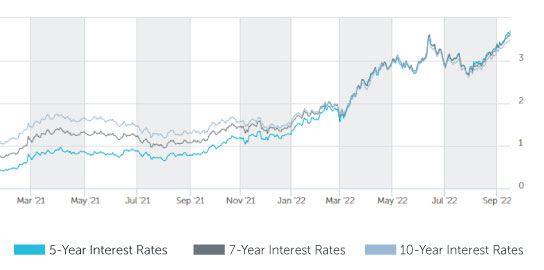September 22, 2022
By Matthew Swerdlow and Matthew Dzbanek; Ariel Property Advisors
The Federal Open Market Committee voted to approve a .75% increase in the federal funds rate to a target range of 3.0% and 3.25% at its sixth meeting of the year. This is the Fed’s third consecutive .75% hike in addition to a .50% increase in May and .25% increase in March. Despite the previous rate hikes, inflation remained relatively unchanged in August increasing by 8.3% from a year ago. In recent speeches and interviews, policymakers have made it clear that they will continue pursuing an aggressive monetary policy until inflation falls to the Fed’s goal of 2%.
“Over the coming months, we will be looking for compelling evidence that inflation is moving down, consistent with inflation returning to 2%,” Fed Chairman Jerome Powell said. “We anticipate that ongoing increases in the target range for the federal funds rate will be appropriate; the pace of those increases will continue to depend on the incoming data and the evolving outlook for the economy. With today’s action, we have raised interest rates by 3 percentage points this year. At some point, as the stance of monetary policy tightens further, it will become appropriate to slow the pace of increases, while we assess how our cumulative policy adjustments are affecting the economy and inflation.”
Although the inflation rate of 8.3% in August was lower than 8.5% in July and 9.1% in June, core CPI, which excludes energy and food prices, rose 6.3% in August, a jump from 5.9% in both June and July. Economists were expecting a month-over-month decline in core CPI but instead price increases spread to more goods and services in August.
Powell noted that reducing inflation will likely result in below-trend growth and a softening in the labor market but that “restoring price stability is essential to set the stage for achieving maximum employment and stable prices over the longer run.”
In his prepared statement, Powell referred to the Fed’s updated Summary of Economic Projections (SEP), which showed the projected median fed funds rate rose to 4.4% in 2022; 4.6% in 2023; 3.9% in 2024; and 2.9% in 2025. In addition, the FOMC lowered its forecast for median real GDP to 0.2% in the fourth quarter; 1.2% in 2023; 1.7% in 2024; and 1.8% in 2025.
The volatile 10-year Treasury has more than doubled since the beginning of the year from 1.514% to 3.512%, following Powell’s announcement, which is boosting borrowing costs. Commercial real estate borrowers have started to feel the pressure of the higher cost of debt in their cash flows. In low cap rate markets, like most parts of New York City, borrowers are also realizing lower loan amounts on their debt quotes for acquisitions and refinances due to standard debt service coverage ratio (DSCR) limits. Lenders are now routinely attempting to predict and plan for future rate increases, increasing their rates even further in an attempt to preempt Fed meetings.
“We’ve had a couple lenders deliberately price themselves out of the market temporarily as they try to predict where and how much the Fed will increase rates,” Swerdlow said. “Each month this has created a short-term opportunity in the debt markets for lenders to grab some market share by waiting just long enough for the Fed announcement to implement new pricing guidance. As always, lenders that offer early rate lock options are superior in this environment.”
Swerdlow noted that in addition to the FOMC’s rate increases, borrowers should be aware that the Fed is shrinking its balance sheet by allowing Treasury and Agency securities to mature without reinvestment. Additionally, their “quantitative tightening” policy will decrease liquidity and put additional upward pressure on interest rates. From June to August, the Fed reduced its securities holdings by up to $47.5 billion per month bringing the balance sheet down to $8.87 trillion on September 15. Beginning in September, the amount of the securities redeemed will rise to $95 billion per month.
The Fed has committed to the task of managing inflation in spite of a worsening economy and increasing unemployment. Commercial real estate borrowers should prepare for a longer than anticipated runway until rates come down.
Multifamily Loan Programs
| Portfolio Lenders | |||
|---|---|---|---|
| Term | Interest Rates | ||
| 5 Year | 5.25% - 5.75% | ||
| 7 Year | 5.50% - 5.75% | ||
| 10 Year | 5.50% - 6.00% | ||
| Agency Lenders | |||
|---|---|---|---|
| Term | Interest Rates | ||
| 5 Year | 5.49%-5.89% | ||
| 7 Year | 5.38%-5.78% | ||
| 10 Year | 5.36%-5.76% | ||
Commercial Loan Programs
| Term | Interest Rates |
|---|---|
| 5 Year | 5.50% - 5.75% |
| 7 Year | 5.75% - 6.00% |
| 10 Year* | 6.25% - 6.75% |
*full-term interest only available
Construction / Development / Bridge (Floating Over 1-month Term SOFR)*
| Type | Interest Rates |
|---|---|
| Stabilized / Core | 250-450 bps |
| Value Add / Core Plus | 450-650 bps |
| Re-Position / Opportunistic | 650+ bps |
Pricing current as of September 22, 2022 and varies with LTV and DSCR
Index Rates
| Index | Interest Rates |
|---|---|
| 5-Year Treasury | 3.91% |
| 7-Year Treasury | 3.84% |
| 10-Treasury | 3.69% |
| Prime Rate | 6.25% |
| 1- Month LIBOR | 2.81% |
| 30-Day Avg. SOFR | 2.28% |
| 1-Month Term SOFR | 3.08% |
| Ameribor Unsecured Overnight Rate | 2.49% |
| Index | Interest Rates |
|---|---|
| 5-Year SOFR Swap | 3.57% |
| 7-Year SOFR Swap | 3.41% |
| 10-Year SOFR Swap | 3.31% |
Pricing current as of September 22, 2022
TREASURY RATES

More information is available from Matthew Swerdlow at 212.544.9500 ext.56 or e-mail mswerdlow@arielpa.com.